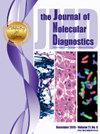利用DNA提取裂解液中的RNA来拯救“不足”的样本,以便在肿瘤标本稀少的患者中进行更全面的基因组分析。
IF 3.4
3区 医学
Q1 PATHOLOGY
引用次数: 0
摘要
组织可用性通常是获得全面基因组谱以确定癌症患者肿瘤中可操作的致癌驱动因素的限制因素。我们之前报道了进行互补DNA和RNA测序以更好地识别靶基因融合的效用。在这里,我们报告了我们的经验,使用从裂解物中回收的RNA,在DNA提取后,进行靶向RNA测序,并在大量实体肿瘤患者中鉴定基因融合和致癌转录物变异。为了验证我们的方法,我们比较了从同一肿瘤中裂解液提取的RNA和直接FFPE提取的RNA的RNA测序结果。在发现致癌基因融合和转录变体的等效鉴定后,我们将研究范围扩大到更大的队列,涵盖更多不同的肿瘤类型。裂解液提取的RNA与新鲜ffpe提取的RNA的成功率分别为97%和96%。在裂解液萃取组中,我们证明裂解液是唯一可用于RNA提取的材料(n = 1,862,占所有测试样品的42%),并且在该亚组中,364(20%)样品在可操作融合或致癌同种异构体中呈阳性。使用从裂解液中回收的RNA可以在实验室中对缺少的FFPE样品进行顺序或同时进行全面的DNA/RNA测序,因为双重样品提取在后勤上是不可能的,允许更完整的分析,以增强可操作的致癌基因融合的识别,以指导护理。本文章由计算机程序翻译,如有差异,请以英文原文为准。
Leveraging RNA from DNA Extraction Lysate to Rescue “Insufficient” Samples for More Comprehensive Genomic Profiling in Patients with Scant Tumor Specimens
Tissue availability is often a limiting factor in obtaining comprehensive genomic profiling to identify actionable oncogenic drivers in tumors from patients with cancer. The utility of performing complementary DNA and RNA sequencing to better identify targetable gene fusions was previously reported. Here, we report our experience using RNA recovered from lysate material, following DNA extraction, to perform targeted RNA sequencing and identify gene fusions and oncogenic transcript variants in a large cohort of patients with solid tumors. To validate this approach, RNA-sequencing results of lysate-extracted RNA and direct formalin-fixed, paraffin-embedded (FFPE) extracted RNA from the same tumors were compared. After finding equivalent identification of oncogenic gene fusions and transcript variants, efforts were expanded to a larger cohort across more diverse tumor types. Lysate-extracted RNA performed comparably to freshly FFPE extract RNA, with 97% and 96% success rates, respectively. Within the lysate-extracted group, it was documented that lysate was the only material available for RNA extraction (n = 1862, 42% of all tested samples) and, within this subgroup, 364 (20%) samples were positive for actionable fusions or oncogenic isoforms. Using RNA recovered from lysate can permit sequential or simultaneous comprehensive DNA/RNA sequencing from scant FFPE samples in laboratories where dual sample extraction is not logistically possible, allowing more complete profiling to enhance the identification of actionable oncogenic gene fusions to guide care.
求助全文
通过发布文献求助,成功后即可免费获取论文全文。
去求助
来源期刊
CiteScore
8.10
自引率
2.40%
发文量
143
审稿时长
43 days
期刊介绍:
The Journal of Molecular Diagnostics, the official publication of the Association for Molecular Pathology (AMP), co-owned by the American Society for Investigative Pathology (ASIP), seeks to publish high quality original papers on scientific advances in the translation and validation of molecular discoveries in medicine into the clinical diagnostic setting, and the description and application of technological advances in the field of molecular diagnostic medicine. The editors welcome for review articles that contain: novel discoveries or clinicopathologic correlations including studies in oncology, infectious diseases, inherited diseases, predisposition to disease, clinical informatics, or the description of polymorphisms linked to disease states or normal variations; the application of diagnostic methodologies in clinical trials; or the development of new or improved molecular methods which may be applied to diagnosis or monitoring of disease or disease predisposition.

 求助内容:
求助内容: 应助结果提醒方式:
应助结果提醒方式:


